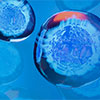chromatography+columns+HyClone+products+(Cytiva)
Catalog Number:
(CA605-4615)
Supplier:
Rockland Immunochemical
Description:
This product has been assayed against 1.0 µg of Goat IgG in a standard capture ELISA using Peroxidase Conjugated Streptavidin and ABTS (2,2’-azino-bis-[3-ethylbenthiazoline-6-sulfonic acid])
Catalog Number:
(10108-796)
Supplier:
Prosci
Description:
DNASE2B shares considerable sequence similarity to, and is structurally related to DNase II. The latter is a well characterized endonuclease that catalyzes DNA hydrolysis in the absence of divalent cations at acidic pH. Unlike DNase II which is ubiquitously expressed, expression of this protein is restricted to the salivary gland and lungs.The protein encoded by this gene shares considerable sequence similarity to, and is structurally related to DNase II. The latter is a well characterized endonuclease that catalyzes DNA hydrolysis in the absence of divalent cations at acidic pH. Unlike DNase II which is ubiquitously expressed, expression of this gene product is restricted to the salivary gland and lungs. The gene has been localized to chromosome 1p22.3 adjacent (and in opposite orientation) to the uricase pseudogene. Two transcript variants encoding different isoforms have been described for this gene.
Catalog Number:
(10110-554)
Supplier:
Prosci
Description:
The structure of MAS1 indicates that it belongs to the class of receptors that are coupled to GTP-binding proteins and share a conserved structural motif, which is described as a '7-transmembrane segment' following the prediction that these hydrophobic segments form membrane-spanning alpha-helices. The MAS1 protein may be a receptor that, when activated, modulates a critical component in a growth-regulating pathway to bring about oncogenic effects.The structure of the MAS1 product indicates that it belongs to the class of receptors that are coupled to GTP-binding proteins and share a conserved structural motif, which is described as a '7-transmembrane segment' following the prediction that these hydrophobic segments form membrane-spanning alpha-helices. The MAS1 protein may be a receptor that, when activated, modulates a critical component in a growth-regulating pathway to bring about oncogenic effects.
Catalog Number:
(10111-502)
Supplier:
Prosci
Description:
TAF5L functions as a component of the PCAF complex. The PCAF complex is capable of efficiently acetylating histones in a nucleosomal context. The PCAF complex could be considered as the human version of the yeast SAGA complex.The product of this gene belongs to the WD-repeat TAF5 family of proteins. This gene encodes a protein that is a component of the PCAF histone acetylase complex. The PCAF histone acetylase complex, which is composed of more than 20 polypeptides some of which are TAFs, is required for myogenic transcription and differentiation. TAFs may participate in basal transcription, serve as coactivators, function in promoter recognition or modify general transcription factors to facilitate complex assembly and transcription initiation. The encoded protein is structurally similar to one of the histone-like TAFs, TAF5. Alternatively spliced transcript variants encoding different isoforms have been identified for this gene.
Catalog Number:
(10111-636)
Supplier:
Prosci
Description:
MGAT2 is a Golgi enzyme catalyzing an essential step in the conversion of oligomannose to complex N-glycans. The enzyme has the typical glycosyltransferase domains: a short N-terminal cytoplasmic domain, a hydrophobic non-cleavable signal-anchor domain, and a C-terminal catalytic domain. Mutations in its gene may lead to carbohydrate-deficient glycoprotein syndrome, type II.The product of this gene is a Golgi enzyme catalyzing an essential step in the conversion of oligomannose to complex N-glycans. The enzyme has the typical glycosyltransferase domains: a short N-terminal cytoplasmic domain, a hydrophobic non-cleavable signal-anchor domain, and a C-terminal catalytic domain. Mutations in this gene may lead to carbohydrate-deficient glycoprotein syndrome, type II. Two transcript variants encoding the same protein have been identified for this gene.
Catalog Number:
(10111-058)
Supplier:
Prosci
Description:
TOP2A is a DNA topoisomerase, an enzyme that controls and alters the topologic states of DNA during transcription. This nuclear enzyme is involved in processes such as chromosome condensation, chromatid separation, and the relief of torsional stress that occurs during DNA transcription and replication. It catalyzes the transient breaking and rejoining of two strands of duplex DNA which allows the strands to pass through one another, thus altering the topology of DNA. Two forms of this enzyme exist as likely products of a gene duplication event. The gene encoding this form, alpha, is localized to chromsome 17 and the beta gene is localized to chromosome 3. The gene encoding this enzyme functions as the target for several anticancer agents and a variety of mutations in this gene have been associated with the development of drug resistance. Reduced activity of this enzyme may also play a role in ataxia-telangiectasia.
Catalog Number:
(10103-772)
Supplier:
Prosci
Description:
The exact function of PURG is not known, however, it is highly similar to purine-rich element binding protein A. The latter is a DNA-binding protein which binds preferentially to the single strand of the purine-rich element termed PUR, and has been implicated in the control of both DNA replication and transcription. The exact function of this gene is not known, however, its encoded product is highly similar to purine-rich element binding protein A. The latter is a DNA-binding protein which binds preferentially to the single strand of the purine-rich element termed PUR, and has been implicated in the control of both DNA replication and transcription. This gene lies in close proximity to the Werner syndrome gene, but on the opposite strand, on chromosome 8p11. Two transcript variants encoding different isoforms have been found for this gene.
Catalog Number:
(10100-202)
Supplier:
Prosci
Description:
SGMS2 is a bidirectional lipid cholinephosphotransferase capable of converting phosphatidylcholine (PC) and ceramide to sphingomyelin (SM) and diacylglycerol (DAG) and vice versa. Direction is dependent on the relative concentrations of DAG and ceramide as phosphocholine acceptors. SGMS2 directly and specifically recognizes the choline head group on the substrate. SGMS2 also requires two fatty chains on the choline-P donor molecule in order to be recognized efficiently as a substrate. SGMS2 does not function strictly as a SM synthase. SGMS2 is required for cell growth.Sphingomyelin (SM) is a major component of plasma membranes. It is preferentially concentrated in the outer leaflet and has a role in the formation of lipid rafts. SM synthases (EC 2.7.8.27), such as SGMS2, produce SM in the lumen of the Golgi and on the cell surface through the transfer of phosphocholine from phosphatidylcholine onto ceramide, yielding diacylglycerol as a side product (Huitema et al., 2004 [PubMed 14685263]).
Supplier:
AGILENT TECHNOLOGIES, INC (CSD) CA
Description:
System capillaries and fittings for efficienct ramp up of usage of your LC instruments.
Supplier:
GLOBAL LIFE SCIENCES SOLUTIONS CA
Description:
ADCF medium for use with hybridoma and myeloma cell lines.
Catalog Number:
(10109-360)
Supplier:
Prosci
Description:
GZMK is a member of a group of related serine proteases from the cytoplasmic granules of cytotoxic lymphocytes. Cytolytic T lymphocytes (CTL) and natural killer (NK) cells share the remarkable ability to recognize, bind, and lyse specific target cells. They are thought to protect their host by lysing cells bearing on their surface 'nonself' antigens, usually peptides or proteins resulting from infection by intracellular pathogens. The protein described here lacks consensus sequences for N-glycosylation present in other granzymes.This gene product is a member of a group of related serine proteases from the cytoplasmic granules of cytotoxic lymphocytes. Cytolytic T lymphocytes (CTL) and natural killer (NK) cells share the remarkable ability to recognize, bind, and lyse specific target cells. They are thought to protect their host by lysing cells bearing on their surface 'nonself' antigens, usually peptides or proteins resulting from infection by intracellular pathogens. The protein described here lacks consensus sequences for N-glycosylation present in other granzymes.
Catalog Number:
(10102-332)
Supplier:
Prosci
Description:
CDC5L shares a significant similarity with Schizosaccharomyces pombe cdc5 gene product, which is a cell cycle regulator important for G2/M transition. CDC5L has been demonstrated to act as a positive regulator of cell cycle G2/M progression. It was also found to be an essential component of a non-snRNA spliceosome, which contains at least five additional protein factors and is required for the second catalytic step of pre-mRNA splicing.The protein encoded by this gene shares a significant similarity with Schizosaccharomyces pombe cdc5 gene product, which is a cell cycle regulator important for G2/M transition. This protein has been demonstrated to act as a positive regulator of cell cycle G2/M progression. It was also found to be an essential component of a non-snRNA spliceosome, which contains at least five additional protein factors and is required for the second catalytic step of pre-mRNA splicing. Publication Note: This RefSeq record includes a subset of the publications that are available for this gene. Please see the Entrez Gene record to access additional publications.
Catalog Number:
(10110-512)
Supplier:
Prosci
Description:
AIFM1 (PDCD8) is a flavoprotein essential for nuclear disassembly in apoptotic cells that is found in the mitochondrial intermembrane space in healthy cells. Induction of apoptosis results in the translocation of this protein to the nucleus where it effects chromosome condensation and fragmentation. In addition, AIFM1 induces mitochondria to release the apoptogenic proteins cytochrome c and caspase-9.This gene encodes a flavoprotein essential for nuclear disassembly in apoptotic cells that is found in the mitochondrial intermembrane space in healthy cells. Induction of apoptosis results in the translocation of this protein to the nucleus where it effects chromosome condensation and fragmentation. In addition, this gene product induces mitochondria to release the apoptogenic proteins cytochrome c and caspase-9. Three alternative transcripts encoding different isoforms have been identified for this gene.This gene encodes a flavoprotein essential for nuclear disassembly in apoptotic cells that is found in the mitochondrial intermembrane space in healthy cells. Induction of apoptosis results in the translocation of this protein to the nucleus where it effects chromosome condensation and fragmentation. In addition, this gene product induces mitochondria to release the apoptogenic proteins cytochrome c and caspase-9. Three alternative transcripts encoding different isoforms have been identified for this gene.
Catalog Number:
(10101-438)
Supplier:
Prosci
Description:
PAX7 is a member of the paired box (PAX) family of transcription factors. Members of this gene family typically contain a paired box domain, an octapeptide, and a paired-type homeodomain. These genes play critical roles during fetal development and cancer growth. The specific function of the paired box gene 7 is unknown but speculated to involve tumor suppression since fusion of this gene with a forkhead domain family member has been associated with alveolar rhabdomyosarcoma. Alternative splicing in this gene has produced two known products but the biological significance of the variants is unknown. This gene is a member of the paired box (PAX) family of transcription factors. Members of this gene family typically contain a paired box domain, an octapeptide, and a paired-type homeodomain. These genes play critical roles during fetal development and cancer growth. The specific function of the paired box 7 gene is unknown but speculated to involve tumor suppression since fusion of this gene with a forkhead domain family member has been associated with alveolar rhabdomyosarcoma. Alternative splicing in this gene has produced two known products but the biological significance of the variants is unknown.
Catalog Number:
(10107-024)
Supplier:
Prosci
Description:
MYC is a multifunctional, nuclear phosphoprotein that plays a role in cell cycle progression, apoptosis and cellular transformation. It functions as a transcription factor that regulates transcription of specific target genes. Mutations, overexpression, rearrangement and translocation of this MYC gene have been associated with a variety of hematopoietic tumors, leukemias and lymphomas, including Burkitt lymphoma.The protein encoded by this gene is a multifunctional, nuclear phosphoprotein that plays a role in cell cycle progression, apoptosis and cellular transformation. It functions as a transcription factor that regulates transcription of specific target genes. Mutations, overexpression, rearrangement and translocation of this gene have been associated with a variety of hematopoietic tumors, leukemias and lymphomas, including Burkitt lymphoma. There is evidence to show that alternative translation initiations from an upstream, in-frame non-AUG (CUG) and a downstream AUG start site result in the production of two isoforms with distinct N-termini. The synthesis of non-AUG initiated protein is suppressed in Burkitt's lymphomas, suggesting its importance in the normal function of this gene.
Catalog Number:
(10111-054)
Supplier:
Prosci
Description:
MYC is a multifunctional, nuclear phosphoprotein that plays a role in cell cycle progression, apoptosis and cellular transformation. It functions as a transcription factor that regulates transcription of specific target genes. Mutations, overexpression, rearrangement and translocation of this MYC gene have been associated with a variety of hematopoietic tumors, leukemias and lymphomas, including Burkitt lymphoma.The protein encoded by this gene is a multifunctional, nuclear phosphoprotein that plays a role in cell cycle progression, apoptosis and cellular transformation. It functions as a transcription factor that regulates transcription of specific target genes. Mutations, overexpression, rearrangement and translocation of this gene have been associated with a variety of hematopoietic tumors, leukemias and lymphomas, including Burkitt lymphoma. There is evidence to show that alternative translation initiations from an upstream, in-frame non-AUG (CUG) and a downstream AUG start site result in the production of two isoforms with distinct N-termini. The synthesis of non-AUG initiated protein is suppressed in Burkitt's lymphomas, suggesting its importance in the normal function of this gene.
Inquire for Price
Stock for this item is limited, but may be available in a warehouse close to you. Please make sure that you are logged in to the site so that available stock can be displayed. If the
Stock for this item is limited, but may be available in a warehouse close to you. Please make sure that you are logged in to the site so that available stock can be displayed. If the
You must log in to order restricted items. We request that you provide the required business documentation to purchase this product for the first time.
To order chemicals, medical devices, or other restricted products please provide identification that includes your business name and shipping address via email CMD_NA@vwr.com or fax 484.881.5997 referencing your VWR account number . Acceptable forms of identification are:
-Additional Documentation May be needed to purchase this item. A VWR representative will contact you if needed.
This product has been blocked by your organization. Please contact your purchasing department for more information.
The original product is no longer available. The replacement shown is available.
This product is currently unavailable but limited stock may be available in our extended warehouse network. Please call 1-800-932-5000 and a VWR Customer Service Representative will help you.
|
|||||||||


































